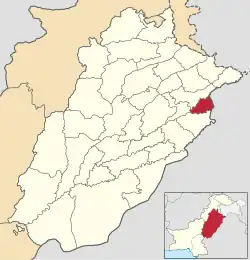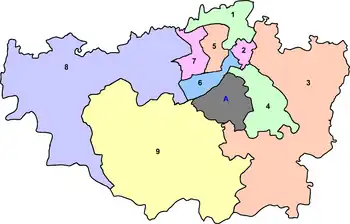Lahore District
Lahore District (Punjabi: ضلع لہور; Urdu: ضلع لاہور) is a district in Punjab, Pakistan, consisting of the provincial capital, Lahore and surrounding areas. It is the most populous district of Pakistan, with a population of over 11 million in 2017.[3][4]
Lahore District
| |
|---|---|
  | |
 Map of Lahore District highlighted within Punjab Province | |
| Coordinates: 31°25′N 74°20′E | |
| Country | |
| Province | |
| Division | Lahore |
| Headquarters | Lahore |
| Government | |
| • Type | District Administration |
| • District Commissioner | Muhammad Ali[1] |
| • District Police Officer | N/A |
| • District Health Officer | N/A |
| Area | |
| • Total | 1,772 km2 (684 sq mi) |
| Elevation | 216 m (709 ft) |
| Population (2017)[2] | |
| • Total | 11,126,285 |
| • Density | 6,300/km2 (16,000/sq mi) |
| Time zone | UTC+5 (PKT) |
| Website | lahore |
The total area is 1,772 square kilometres (684 sq mi). Before 1976, district Lahore had 3 tehsils. Tehsil Lahore, Tehsil Kasur and Tehsil Chunian. But in 1976, Kasur became district and separate from Lahore District.[5][6]
Administration
The district is administratively subdivided into five tehsils.
| Name of Tehsil | No of Union Councils |
|---|---|
| Lahore Cantt[2] | |
| Lahore City | |
| Model Town[2] | |
| Raiwind | |
| Shalimar[2] |
Demography
At the time of the 2017 census, the district's population was 11,126,285, with 5,813,987 males and 5,303,982 females. It was entirely urban. The literacy rate was 77.08%. Muslims were 94.71% of the population while Christians were 5.14% of the population.[7][2]
At the time of the 2017 census, 80.94% of the population spoke Punjabi, 12.62% Urdu and 2.71% Pashto as their first language.
| Religion | Population (1941)[8]: 42 | Percentage (1941) |
|---|---|---|
| Islam |
1,027,772 | 60.62% |
| Sikhism |
310,646 | 18.32% |
| Hinduism |
284,689 | 16.79% |
| Christianity |
67,686 | 3.99% |
| Others [lower-alpha 3] | 4,582 | 0.27% |
| Total Population | 1,695,375 | 100% |
Education
According to Pakistan District Education Rankings, a report by Alif Ailaan, Lahore is ranked nationally at 32 with a score of 69.2 and learning score of 53.93. Lahore ranks nationally at number 1 in terms of readiness score, with a score of 93.51. According to PEC assessments, Lahore ranks last out of all districts of Punjab in both class 5 and class 8.
Science labs in schools are either not available or have inadequate instruments which also affects quality. The school infrastructure score of Lahore is 91.32, ranking it 29th nationally. Still few schools in a major district like Lahore have open air or dangerous classrooms.
Issues mainly reported in TaleemDo! app[14] from Lahore are that students want to study in private schools, as they are better than government schools but can not afford the fee. A communication gap between the teachers and the students was also reported and a few reported some facilities problems in their school.
See also
References
- "Lahore: 'Roti' price increases Rs2 without district govt's permission". Dunya News. 22 January 2023. Retrieved 22 January 2023.
- "District and Tehsil Level Population Summary with Region Breakup" (PDF). Pakistan Bureau of Statistics website. Archived from the original (PDF) on 27 August 2018. Retrieved 3 July 2023.
- "Towns and Unions in the City District of Lahore". National Reconstruction Bureau, Government of Pakistan website. Archived from the original on 9 February 2012. Retrieved 3 July 2023.
- "Lahore District". Digital South Asia Library, University of Chicago website. Retrieved 3 July 2023.
- "Geographical Boundaries of Lahore". lahore.punjab.gov.pk. Retrieved 10 May 2023.
- "Punjab-Lahore -". Retrieved 10 May 2023.
"Lahore district is bounded on the north and west by Sheikhupura district, on the east by India's Amritsar district, and on the south by Kasur district. River Ravi flows on the northern side of Lahore, and separates it from Sheikhupura district.
- "PUNJAB: Lahore District population per 2017 census". Citypopulation.de website. Archived from the original on 29 April 2020. Retrieved 3 July 2023.
- "CENSUS OF INDIA, 1941 VOLUME VI PUNJAB PROVINCE". Retrieved 21 July 2022.
- "SALIENT FEATURES OF FINAL RESULTS CENSUS-2017" (PDF). Retrieved 20 May 2021.
- "Religions in Pakistan | PEW-GRF". www.globalreligiousfutures.org.
- "Refworld | World Directory of Minorities and Indigenous Peoples - Pakistan : Christians".
- Riazul Haq and Shahbaz Rana (27 May 2018). "Headcount finalised sans third-party audit". Retrieved 23 January 2021.
- "Population By Religion" (PDF). Pakistan Bureau of Statistics, Government of Pakistan: 1.
"Population Distribution by Religion, 1998 Census" (PDF). Pakistan Bureau of Statistics. Retrieved 12 July 2020. - "Taleem Do! App – Elections 2018 | #TaleemDo". Archived from the original on 3 August 2018. Retrieved 13 August 2018.
- Historic district borders may not be an exact match in the present-day due to various bifurcations to district borders — which since created new districts — throughout the historic Punjab Province region during the post-independence era that have taken into account population increases.
- 1941 census: Including Ad-Dharmis
- Including Jainism, Buddhism, Zoroastrianism, Judaism, or not stated

